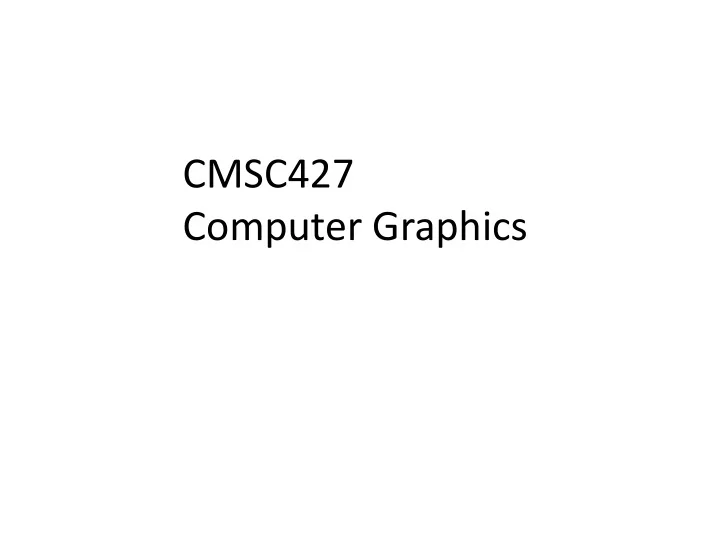

CMSC427 ¡ Computer ¡Graphics
Staff Instructor Prof. ¡Roger ¡Eastman Teaching ¡assistant Patrick ¡Owen
Today • Course ¡overview: ¡what ¡and ¡why • Course ¡organization: ¡how • Getting ¡started: ¡Drawing ¡curves
Computer graphics
Key topics this semester • Modeling • Rendering • Interaction
Modeling • Creating ¡models ¡of ¡ objects and ¡ scenes • Shape • Appearance • Behavior/animation • Techniques • By ¡hand • By ¡algorithm • By ¡capture http://en.wikipedia.org/wiki/3D_modeling
Modeling by hand • Example: ¡Blender ¡(freeware) • https://www.blender.org • Professional ¡tools • Artistic ¡(Maya, ¡Lightwave) • Engineering ¡(Autocad, ¡Solidworks) • General ¡(Sketchup) • Free ¡AND ¡easy ¡(Tinkercad) • Search ¡for ¡3D ¡modeling ¡tool
Modeling by procedure • Creating ¡shape, ¡behavior ¡by ¡algorithm Sweeping ¡Fractal ¡Lines Dan ¡Gries (newly ¡generated ¡pic) E-‑on ¡Vue software ¡for ¡procedural ¡environments
Modeling by capture • Measure ¡values ¡from ¡real ¡world ¡ • 3D ¡scanner ¡for ¡static ¡shapes ¡ • Structure ¡IO ¡sensor • Trnio/Scann3D ¡on ¡phones • Will ¡do ¡in ¡this ¡class • Motion ¡capture ¡for ¡dynamics
Rendering • Synthesis ¡of ¡2D ¡image ¡from ¡3D ¡scene • http://en.wikipedia.org/wiki/Rendering_(computer_graphics) • Input • Data ¡structure ¡that ¡stores ¡object ¡and ¡scene ¡info ¡ (geometry, ¡material ¡properties, ¡lights, ¡camera) • Output • 2D ¡image ¡(array ¡of ¡pixels) • Red, ¡Green, ¡Blue ¡values ¡for ¡each ¡pixel ¡
Photorealistic rendering • Physically ¡based ¡simulation ¡of ¡light, ¡materials, ¡ camera. ¡Slow, ¡rendering ¡farms, ¡is ¡constantly ¡ evolving. ¡Soft ¡shadows, ¡realistic ¡surfaces. Jin ¡Hee ¡Lee
Interactive rendering • Real ¡time, ¡realistic ¡but ¡approximate ¡physics. ¡ Uses ¡specialized ¡GPUs, ¡standard ¡APIs ¡ (OpenGL). ¡Hard ¡shadows, ¡cheats ¡in ¡lighting.
Non-photorealistic rendering • Stylized, ¡cartoonish, ¡for ¡artor illustration • https://en.wikipedia.org/wiki/Non-‑photorealistic_rendering
Beyond 2D rendering … • Stereo ¡VR ¡rendering • Haptic ¡feedback ¡ • virtual ¡objects • Ultrasound, ¡Univ. ¡of Bristol • 3D ¡printing!
Interaction – input • Broad ¡range ¡of ¡input ¡devices ¡beyond ¡ keyboard, ¡mouse • Event ¡driven ¡programming
The Why? • What’s ¡your ¡interests? • What’s ¡your ¡experience? • Why ¡are ¡you ¡taking ¡this ¡course, ¡and ¡what ¡ do ¡you ¡want ¡to ¡get ¡out ¡of ¡it? • Graphics ¡resume ¡assignment ¡for ¡Thursday • On ¡Canvas • Submit ¡on ¡Piazza
Course objectives 1. Write ¡efficient ¡interactive ¡2D ¡and ¡3D ¡graphics ¡ programs ¡using ¡different ¡graphics ¡systems. ¡ 2. Create ¡object ¡and ¡scene ¡shape ¡and ¡behavioral ¡ models ¡using ¡algorithmic ¡techniques. 3. Render ¡these ¡models ¡at ¡varying ¡levels ¡of ¡ photorealism. 4. Describe ¡and ¡apply ¡mathematical ¡and ¡ algorithmic ¡foundations ¡as ¡needed ¡for ¡ programming, ¡modeling ¡and ¡rendering.
Graphics systems (limited list of examples!) Languages 3D ¡real ¡time ¡APIs Game ¡engines C/C++ DirectX Unity Java ¡(with ¡JOGL) OpenGL Unreal Java-‑Processing Vulcan Blender Javascript GLSL Godot Python WebGL Horde3D Rendering ¡engines Widget ¡sets Physics ¡engines POV-‑Ray QT ¡with ¡C/C++ Box2D Orge Java Bullet Yafaray Javascript/HTML Open ¡Dynamics Keyshot TCL/TK Chipmunk2D Renderman GLUT ¡ Moral: ¡evolving, ¡must ¡learn ¡to ¡learn
Course schedule • Unit ¡I ¡– Object ¡modeling: ¡curves ¡and ¡surfaces • Unit ¡II ¡– Basics ¡of ¡rendering ¡and ¡OpenGL • Unit ¡III ¡-‑ Scene ¡modeling: ¡composite ¡objects ¡and ¡ scene, ¡3D ¡interactivity • Unit ¡IV ¡– Advanced ¡rendering ¡for ¡realism • Unit ¡V ¡– Advanced ¡modeling ¡for ¡complex ¡shapes
Course organization • Lecture • CSI 1121 TuTh 3:30-‑4:45 ¡pm • Canvas • Course ¡material ¡and ¡assignments ¡will ¡be ¡posted ¡here. • Piazza • We ¡will ¡use ¡a ¡class ¡discussion ¡forum ¡for ¡answering ¡ lecture ¡and ¡assignment ¡questions. ¡
Staff Instructor Prof. ¡Roger ¡Eastman ¡(reastman@umd.edu) Office ¡and ¡hours: ¡ A.V. ¡Williams Teaching ¡assistant Patrick ¡Owen ¡(patowen95@gmail.com) Office ¡ ¡and ¡hours: A.V. ¡Williams ¡
Textbooks • Required: ¡None • Provided: ¡David ¡Mount ¡notes ¡on ¡foundations • Recommended for ¡projects ¡(trade ¡books): • OpenGL ¡Superbible (6th ¡edition), ¡by ¡G. ¡Sellers, ¡R. ¡S. ¡Wright, ¡ and ¡N. ¡Haemel, ¡2013. • Anton’s ¡OpenGL ¡4 ¡Tutorials, ¡by ¡Anton ¡Gerdelan, ¡Amazon ¡ Digital ¡Services, ¡2014. • OpenGL ¡Shading ¡Language ¡(3rd ¡Edition), ¡by ¡Randi ¡J. ¡Rost (Author), ¡et ¡al., Addison-‑Wesley ¡Professional, ¡2009 • Recommended ¡for ¡general ¡material ¡(textbooks): • Computer ¡Graphics ¡Programming ¡in ¡OpenGL ¡with ¡Java, ¡V. ¡ Scott ¡Gordon ¡and ¡John ¡Clevenger, ¡Mercury, ¡2017 • Fundamentals ¡of ¡Computer ¡Graphics, ¡Fourth ¡Edition ¡4 th (3 rd ) ¡ Edition, ¡by ¡Steve ¡Marschner and ¡Peter ¡Shirley, ¡AK ¡Peters ¡2015
Web resources • Khronos group: • https://www.khronos.org • Online ¡web ¡tutorials ¡of ¡quality: • https://learnopengl.com Joey ¡de ¡Vries • http://www.iquilezles.org/www/index.htm • http://learningwebgl.com/blog/ • Additional ¡relevant ¡online ¡sources ¡will ¡be ¡ distributed ¡through ¡the ¡semester
Prerequisites Assume ¡you Know ¡Java ¡ Know ¡OOP ¡and ¡data ¡structures ¡(420) Are ¡familiar ¡with ¡some ¡linear ¡algebra Will ¡review Matrix ¡operations Don’t ¡assume ¡you Have ¡programmed ¡graphics ¡before Have ¡written ¡interactive ¡programs
Assignments and workload • Homework ¡(25%) • Weekly ¡homeworks of ¡varying ¡effort ¡and ¡worth • Quizzes ¡and ¡exams ¡(30%) • Projects ¡and ¡labs ¡(45%) • Labs: ¡short, ¡focused ¡programming ¡exercises ¡on ¡ particular ¡concepts • Projects: ¡more ¡substantial ¡programming ¡efforts
Processing • Complete ¡open ¡source, ¡freeware ¡graphics ¡ system ¡from ¡IDE ¡to ¡language ¡to ¡API • Designed ¡for ¡artists, ¡other ¡”non-‑CS” ¡types • Ben ¡Fry ¡and ¡Casey ¡Reas @ ¡MIT • Large ¡ecology ¡of ¡supporting ¡libraries • Used ¡this ¡semester ¡to ¡sketch ¡ideas • Can ¡be ¡downloaded, ¡or ¡used ¡online: • https://processing.org • http://sketchpad.cc
Recommend
More recommend